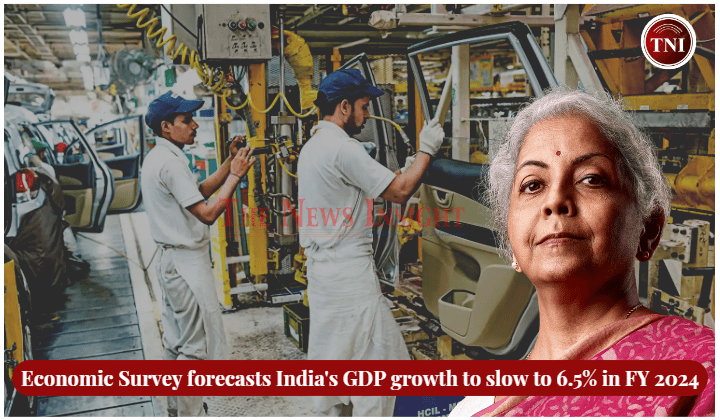Earlier in the day, Union Finance Minister Nirmala Sitharaman gave a head start to this year’s budget session by introducing the pre-Budget Economic Survey 2022-23 ahead of her presentation of the Union budget in the lower House of Parliament scheduled on February 1st.
Support Independent Journalism? Keep us live.
Dr V Anantha Nageswaran, the chief economic advisor (CEA), held a press conference at 2 p.m. to unveil the document to the public.
Meanwhile, Sitharaman’s speech was preceded by President Droupadi Murmu’s pre-budget session address, which was delivered to members of both the Rajya Sabha and the Lok Sabha in a joint session; the President’s address marks the start of Parliament’s budget session. This was also President Murmu’s first budget session speech since becoming the country’s second female head of state in July last year (after Pratibha Patil).
Economic growth will slacken in the fiscal year.
India’s economic growth is expected to slow to 6.5 percent in the fiscal year beginning in April, but the country will remain the world’s fastest growing major economy. This GDP growth projection compares to an estimated 7% expansion in the current fiscal year (April 2022 to March 2023) and 8.7% expansion in 2021-22.
In terms of purchasing power parity (PPP), India is the world’s third largest economy, and the fifth largest in terms of exchange rate. “The economy has nearly recovered what was lost, renewed what had stalled, and re-energized what had slowed during the pandemic and since the conflict in Europe,” according to the survey.
The RBI’s forecast for retail inflation in the current fiscal year of 6.8 percent is neither too high nor too low to discourage private consumption or investment. However, entrenched inflation may prolong the tightening cycle and therefore, borrowing costs may stay “higher for longer”. Retail inflation in India fell below 6% in November after remaining above the RBI’s upper tolerance level for the previous ten months since January 2022.
The survey also urges close monitoring of the current account deficit (CAD), which may widen further as global commodity prices rise. According to the most recent Reserve Bank data, the CAD increased to 4.4 percent of GDP in the September quarter from 2.2 percent in the April-June period due to a larger trade gap. “While commodity prices have fallen from record highs, they remain higher than pre-conflict levels. Strong domestic demand combined with high commodity prices will increase India’s total import bill and contribute to negative current account developments. These could be exacerbated by slowing export growth as a result of weakening global demand. “If the current account deficit widens further, the currency may face depreciation pressure,” the survey further added.
Indian Rupee projected to remain under depreciation.
Because of the plateauing of exports and subsequent widening of the current account deficit, the Indian rupee may continue to depreciate. According to the report, “risks to the current account balance stem from a variety of sources.”
Meantime, Real estate buoyancy, combined with improved construction activities, created jobs and facilitated the return of migrant workers to cities. This is significant in light of job losses caused by lockdown restrictions during various pandemic waves since March 2020. While Credit growth for MSMEs is expected to be rapid in FY 2023-24, assuming inflation remains low and credit costs remain low. Credit to micro, small, and medium-sized businesses increased by about 31% from January to November 2022.
Capital expenditure has begun to push private investment, and the current fiscal year’s budget target of Rs 7.5 lakh crore is likely to be met. The central government’s capital expenditure (capex), which increased by 63.4 percent year on year in the first eight months of FY23, was another growth driver for the Indian economy, crowding out private capex beginning in the January-March quarter of 2022.
Foreign direct investment (FDI) is expected to rebound in the coming months as a result of India’s strong economic growth and steps to improve the country’s business environment. Because of the increased global uncertainty caused by the Russia-Ukraine conflict, FDI equity inflows into the manufacturing sector in the first half of the current fiscal year (April-September) were lower than in the first half of 2021-22.
After a two-year lull, housing prices have begun to firm up, and unsold inventories have decreased as demand has increased. The survey predicts a drop in prices as a result of a reduction in import duties on many building materials.
The country’s civil aviation sector has “great potential” due to rising middle-class demand, higher disposable incomes, and favourable demographics, while air travel has recovered following the removal of pandemic-related restrictions.
The agriculture sector has performed well, but it requires “re-orientation” in the face of certain challenges such as the negative effects of climate change, rising input costs, and so on. Other issues include fragmented landholdings, suboptimal farm mechanisation, low productivity, hidden unemployment, and rising input costs.
Gross tax revenues reached Rs 17.81 lakh crore, or 65 percent of the Budget estimate, during the first eight months of the current fiscal year until November, propelled by corporate and personal income tax mop-up. “Substantial reforms” in India’s taxation ecosystem following 2014, as well as policy reforms, have removed the economy’s distortionary incentives.


Comments are closed.